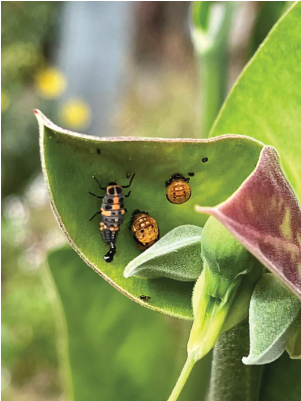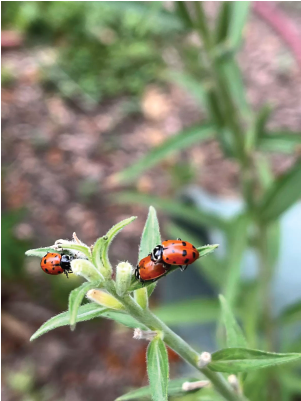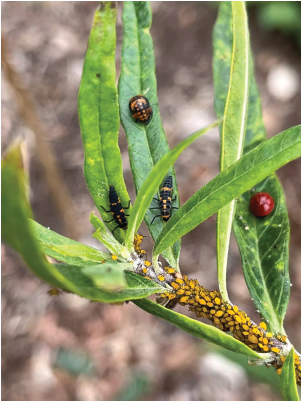At any life stage, ladybugs are a garden’s friend

This ladybug larva (left) will transform into the inactive pupal stage (center and right). (Susan Pransky)
At any life stage, ladybugs are a garden’s friend
(This article originally appeared in the San Diego Union-Tribune October 14, 2023)
If you saw an insect that vaguely resembled a tiny alligator on one of your plants, would you think that perhaps you should remove it, squish it or run for the spray? You are most likely looking at ladybug larvae, which is one of a gardener’s very best friends.
Ladybugs are a “natural enemy” of aphids, scales, spider mites and other insect pests. “Natural enemy” means you don’t have to spray to remove those insect pests, because ladybugs will handle the problem for you. In fact, spraying would probably do more harm than good, because it would likely kill the natural enemy, also known as a “beneficial insect,” which would then permit the insect pests to replicate even faster.
We all know what adult ladybugs look like, but even experienced gardeners may be unfamiliar with the appearance of ladybugs in their most valuable and mysterious form. This is important information, because one ladybug can eat up to 5,000 insects in its lifetime. Larvae are elongated and spiky-looking, with six legs. They are black, dark brown or dark grey, with orange or yellow spots.
The larval stage of ladybugs most often feeds on aphids and is most likely to be found on plants that have many aphids on them. Most established plants can tolerate aphids. If you feel the need to reduce the number of aphids on your plants, they can be knocked off by shaking the plant or spraying it with a strong stream of water. Since ants protect aphids from natural enemies, keeping ants off plants helps beneficial insects do their job.

Adult ladybugs lay hundreds of eggs over about two months. (Susan Pransky.)
Ladybugs are also called “lady beetles” or, in Europe, “ladybird beetles.” Like other beetles, ladybugs develop through complete metamorphosis with an egg, larval, pupal and adult stage. Adult ladybugs lay hundreds of eggs over the course of approximately two months. The eggs are oblong and often yellow or orange. They are laid on the underside of leaves in groups of 10 to 30 in colonies of aphids and other plant-eating pests. Larvae emerge from eggs in a few days, and as soon as the eggs hatch, they start eating. Larvae grow quickly and shed their skin several times. When they reach full size of up to ⅓ of an inch, they attach to a leaf by their tail, develop a hard case, and enter a resting stage called the pupa. The pupa stage lasts one to two weeks and then the adult ladybug emerges, ready to eat more aphids.
Ladybugs are most active from spring until fall and do not fly if it is below 55 degrees. Reproduction stops when day length shortens. Development from egg to adult takes about six weeks during the growing season. Ladybugs overwinter mostly as adults in protected places such as buildings, ground cover or logs. Their version of hibernation is called diapause. They can have up to five generations per year.
Besides unsuspecting gardeners, the main predators of ladybugs are birds. Ladybugs are also the prey of frogs, wasps, spiders and dragonflies. Although adult ladybugs are thought of as being red with black spots, they can be many colors, including black, yellow and grey. They can have square or irregularly shaped spots, or no spots at all, and can even be striped.
Ladybugs were responsible for the first highly successful use of biological or “natural control” via the importation of a beneficial insect. In the late 1800s, the vedalia beetle (Rodolia cardinalis) was imported to the U.S. to control cottony cushion scale, which was extremely destructive to citrus. The beetle was highly effective. Ladybugs have also been introduced to the Galapagos to reduce cottony cushion scale and have been beneficial there as well.

The larval (tiny alligator-looking) and pupal (round) stages of a ladybug along with aphids (yellow clusters) that will likely be their meal. (Susan Pransky)
To keep enemies away, ladybugs can release a foul-smelling chemical from their “knees.” Predators avoid eating ladybugs after learning that color combinations of bright orange, red and black can mean an unpleasant taste. Even ladybugs that are not distasteful mimic the colors of the poisonous ones to gain protection from predators.
Purchasing and releasing ladybugs into the home garden may not be an effective method of pest control. In many situations, the ladybugs fly away or, because of the capture method, are not healthy enough to survive. Attracting ladybugs to the garden is easy, however, with a mix of pollinator-friendly plants, limited use of pesticides and leaving a few aphids for them to eat. If ladybugs are not present, often a strong stream of water is most effective for reducing populations of harmful insects.
Vintners take note: There are about 5,000 species of ladybugs, with about 175 of them in California. The Asian lady beetle, one of the species found in California, feeds on grapes late in the season and its flavor can contaminate wine if harvested with the fruit.
In many places, ladybugs are believed to be omens of good luck. In England, finding a ladybug is interpreted to mean there will be a good harvest.
Pransky, a Master Gardener since 2012, has gardened in San Diego for more than 30 years.

